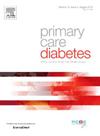Enhanced glycemic control and cardiovascular risk reduction in type 2 diabetes patients using quantified tableware: A randomized controlled study
IF 2.6
4区 医学
Q3 ENDOCRINOLOGY & METABOLISM
引用次数: 0
Abstract
In diabetes, nutrition therapy necessitates effective management strategies to improve blood glucose levels, blood pressure, and lipid profiles, thereby lowering the risk of cardiovascular disease and stroke. Tableware is a food-level strategy to accurately measure food consumed and control food portion size. This prospective, randomized study investigated the impact of quantified tableware (QTW) on glycemic control in T2DM patients. Conducted at Mackay Memory Hospital, Taiwan, from August 2015 to December 2016, the study included 94 adult T2DM participants with poor glycemic control (HbA1c >7 %), randomly assigned to control (n = 47) and intervention (n = 47) groups. All participants received regular counseling from the dietician, while the intervention group additionally used a set of QTW designed by the Taiwanese Association of Diabetes Educators to accurately measure all the food consumed per meal in appropriate proportions. The primary aim was the change in HbA1c at 12 months. Secondary aims included achieving HbA1c < 7 %, BP < 140/90, and LDL < 100 mg/dl, known as the ABC goals (HbA1c, blood pressure, LDL). Seventy-seven patients, 43 in the control group and 34 in the intervention group completed the study. After 12 months, the intervention group showed a significant reduction in HbA1c levels compared to the control group (-0.7 ± 0.9 vs −0.2 ± 1.0 %, p = 0.037). Additionally, 32.4 % of the intervention group achieved HbA1c < 7 %, compared to 11.6 % in the control group (p = 0.026). Achievement of the LDL goal and any two of the ABC goals significantly increased only in the intervention group. Using QTW improved glycemic control and achievement of the LDL goal in T2DM patients. These results indicate that QTW can effectively enhance glycemic control, blood pressure, and lipid profiles in T2DM patients. Further studies are needed to confirm these findings and explore broader applications.
使用量化餐具增强2型糖尿病患者血糖控制和心血管风险降低:一项随机对照研究
在糖尿病中,营养治疗需要有效的管理策略来改善血糖水平、血压和血脂,从而降低心血管疾病和中风的风险。餐具是一种食物水平的策略,可以准确地测量食物的消耗和控制食物的份量。这项前瞻性、随机研究调查了量化餐具(QTW)对2型糖尿病患者血糖控制的影响。该研究于2015年8月至2016年12月在台湾Mackay记忆医院进行,纳入了94名血糖控制不良的成年T2DM参与者(HbA1c >.7 %),随机分为对照组(n = 47)和干预组(n = 47)。所有参与者都接受营养师的定期咨询,而干预组则使用一套由台湾糖尿病教育者协会设计的QTW来准确测量每餐所消耗的所有食物的比例。主要目标是12个月时HbA1c的变化。次要目标包括达到HbA1c
本文章由计算机程序翻译,如有差异,请以英文原文为准。
求助全文
约1分钟内获得全文
求助全文
来源期刊

Primary Care Diabetes
ENDOCRINOLOGY & METABOLISM-PRIMARY HEALTH CARE
CiteScore
5.00
自引率
3.40%
发文量
134
审稿时长
47 days
期刊介绍:
The journal publishes original research articles and high quality reviews in the fields of clinical care, diabetes education, nutrition, health services, psychosocial research and epidemiology and other areas as far as is relevant for diabetology in a primary-care setting. The purpose of the journal is to encourage interdisciplinary research and discussion between all those who are involved in primary diabetes care on an international level. The Journal also publishes news and articles concerning the policies and activities of Primary Care Diabetes Europe and reflects the society''s aim of improving the care for people with diabetes mellitus within the primary-care setting.
 求助内容:
求助内容: 应助结果提醒方式:
应助结果提醒方式:


